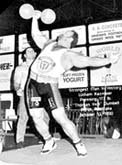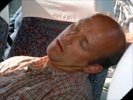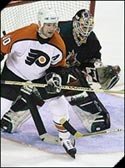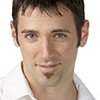For this month's update, our good friend and true hockey aficionado, Ryan Foster, has submitted an excellent 3-part article delving into the theory and practice of hockey training. Ryan is an accomplished hockey player and coach as well as a great strength coach in his own right.
This month's article will focus on how to develop a periodized hockey program. It also addresses the first phase of this program, the hypertrophy phase.

Unnecessary Roughing

Ever walk into a room and feel a little over-awed by what you see? I'm sure it has happened to all of us at least once or twice in our lives. How about the first time you walked into a gym as a 17-year-old kid after reading Flex magazine's 56th edition of 'top 10 ways to gain mass,' then low and behold, you saw some monster squatting five wheels a side for an easy ten reps.
 Or how about having to walk through the Radisson Hotel in Columbus Ohio, and nearly having to become one with the hallway wall so that Bill Kazmeir can make his way through? Oh yeah, Bill Kazmeir provokes awe.
Or how about having to walk through the Radisson Hotel in Columbus Ohio, and nearly having to become one with the hallway wall so that Bill Kazmeir can make his way through? Oh yeah, Bill Kazmeir provokes awe.
One of my major bouts of awe occurred in the fall of 1999 as I stood at the entrance of a hotel conference room and watched as 60 of the most intimidating figures I had ever seen walked by. Most were dressed in T-shirts, sandals and shorts. They were in possession of doorway wide shoulders and legs that resembled tree trunks.
The group chatted only minimally and had a look of seriousness and purpose in their faces that was not unlike a certain boxer named Balboa, whom one commentator stated 'the champ has a look tonight that could burn through lead.' I don't know about lead, but their looks were scary enough to melt ice.
Along with the eye of the tiger look came many 1-to-4 inch scars and more than the occasional disfigured nose. It looked as if some ofthese guys regularly vacationed in Bosnia or Iraq.
Well, it didn't look like the preliminary heats for the world's strongest man competition, as there were no 300-plus pounders here. And it certainly wasn't a professional bodybuilding competition; these guys were too tall and, let's face it, too ugly for that.
A military boot camp might fit the bill, but most of these guys looked more like rabble-rousers than keepers of the peace. With the sandals and shorts it could have been the set of Baywatch, but pretty boy actors don't have 4-inch scars on their chins.
So what was this event and who were all these guys?
It was, in fact, the NHL's Philadelphia Flyers and they were here in Peterborough Ontario for training camp. And what was I doing here? Trying to whip these boys into shape.
Throughout the next week this group of athletes took part in fitness testing that involved such things as bench presses for maximum reps, maximum number of wide grip chins and either a 23-mile bike ride or 6-mile run through the winding hills of the Kawarthas.
This was followed by two more weeks of vigorous on ice practices to prepare for the season. Then, the pre-season games began as a prelude to a grueling seven-month, 84 game regular season. Since these guys make the playoffs, there are a few extra weeks tacked on for good measure.
This crew (and similar other crews like them) and the demands of their sport are indeed impressive. Most of these guys stand at 6 feet in height and 200 pounds with a body fat percentage somewhere between 6 and 12%. Now that doesn't sound too astronomical, but let's take into account that these guys are extremely skill based, functionally strong, anaerobically and aerobically fit, not to mention tough.
 You know, the kind of tough that enables them to jersey that stingy neighbor Al, who still hasn't returned your chainsaw, and feed him upper cuts until he drops like a sack of potatoes while simultaneously flipping a sirloin steak and swilling a Molson.
You know, the kind of tough that enables them to jersey that stingy neighbor Al, who still hasn't returned your chainsaw, and feed him upper cuts until he drops like a sack of potatoes while simultaneously flipping a sirloin steak and swilling a Molson.
Some of the best and more notable players at the camp were pure and freaky physical specimens, to say the least. Take for instance guys such as John Leclair, 6-foot-3, 226 pounds, Michael Renberg, 6-2, 218, Dan McGillis 6-2, 234, Rod Brind'Amour 6-0, 200, and of course Eric Lindros 6-4, 236 (Lindros won the Flyers' Top Fitness award in 1998).
Couple this size with some impressive strength, athletic ability and aggressiveness and you've got yourself a fab-5 lineup that could take on Lexx Luther and the Cobra Commander any day. Rumor has it that these guys eat roughly 24 Philly steak and cheese hoagies after games, snap hockey sticks in half and use the splinters as toothpicks.
Since I have some experience in working with these types of monsters, I'd like to share with you some of the training secrets those hockey players have tucked up their sleeves. In this article I will introduce the theory of periodization and discuss how hockey players should train for muscle growth (or hypertrophy, for you science types). In future articles, I'll introduce the concepts of maximal strength training, speed/power training, anaerobic training and skill-specific training.

Plan For The Pain - Periodization

As the hockey season ends, banged up players usually pack up their gym bags and head to their summer homes and cottages in the beautiful Rocky Mountains of Alberta and the amazing Muskoka Lakes of central/northern Ontario. At this time the only thing on their minds is a little R & R. And that is precisely what they should be doing.
After playing 84-plus games of hard-core hockey the body and mind craves a little rest. So I advise that players take a minimum of 1-2 weeks off from doing any type of physical training after their season ends. When I say this I mean none, nothing! These 1-2 weeks off before the start of a rigorous training program will pay large dividends in the future.

 |
All About Recovery! Below I will discuss some secrets that I use with my athletes. When talking about recovery from training and competition, there are basically 5 areas to focus on. [ Click here to learn more. ] |

During this recovery time, however, athletes must be planning for their next season. Since there is only a maximum of 16-to-18 weeks of solid training that one can get in before the up-coming season, a well thought out plan must be put in place. This is where I look to the theory of periodization to play a big role.
Quite simply, periodization can be taken as dividing a training program up into several phases. For elite hockey players I suggest dividing the off-season training program into three phases - hypertrophy (big), maximal strength (strong) and power (fast).
The thinking the process behind dividing training into three separate phases instead of embarking on them all at once is that an athlete will receive greater benefit in all three areas by dividing them up into their own specific phase. For instance an athlete will gain greater muscle size by channeling all of their efforts into hypertrophy training rather than worry about maximal strength training at the same time.

 |
Periodization: Which Method Is Best? Periodization, simply stated, is the organization of training into blocks or units of time that focus on specific skills. Read more! [ Click here to learn more. ] |

Secondly it is extremely difficult to lift the heavy loads used for maximal strength training after completing hypertrophy work. The same can be said toward training for power, as a fatigued muscle cannot contract nearly as fast as a rested muscle.
And that's the whole point of speed/power training, isn't it? The result being a muscle that learns to contract slowly which is just the opposite of what a hockey player is looking for.
Having said that, I suggest splitting up the training phases and allotting time increments to them in the following manner:
 Get Big - Hypertrophy - 4 weeks
Get Big - Hypertrophy - 4 weeks
 Get Strong - Maximal Strength - 6 weeks
Get Strong - Maximal Strength - 6 weeks
 Get Fast - Power - 4 weeks
Get Fast - Power - 4 weeks
 Now some of you may be saying 'hey wait a minute Fozz, that only adds up to 14 weeks and there are 18 weeks in which to train'. True, but keep in mind that the body needs time to rest and recuperate. A train can only chug along for so long before it needs to stop and refill its tanks, and the body is no different.
Now some of you may be saying 'hey wait a minute Fozz, that only adds up to 14 weeks and there are 18 weeks in which to train'. True, but keep in mind that the body needs time to rest and recuperate. A train can only chug along for so long before it needs to stop and refill its tanks, and the body is no different.
So, in the above example the athlete would take a week off at the end of the season, a week off between each phase of training, and a week off before heading to training camp. That adds up to four weeks. Add those 4 weeks to the 14 weeks of actual training and we get 18 weeks of off-season time.
Having described how off-season training is divided into three separate phases, let's take a look at one of these phases in more detail, the hypertrophy phase. Again, the other phases will be addressed in upcoming articles.

Gettin' Big - Hypertrophy Training

One of the more popular questions I hear from players goes a little something like this, 'Hey man, I don't want to get too big and bulky; and anyways, why would anyone want to train to become more muscular in a sport that requires strength and speed'? Well, quite simply hockey is like many other contact sports in that the more one weighs the harder it is to stop them once they are in motion.
 I ask you a question, who is harder to knock off the puck, Marc Savard or John Leclair? Leclair, of course. Leclair outweighs Savard by about 36 pounds. That added weight surely helps Leclair while battling along the boards and in front of the net. In hockey, like in many other sports the more muscle one has the better.
I ask you a question, who is harder to knock off the puck, Marc Savard or John Leclair? Leclair, of course. Leclair outweighs Savard by about 36 pounds. That added weight surely helps Leclair while battling along the boards and in front of the net. In hockey, like in many other sports the more muscle one has the better.
The only instances that I would prescribe laying off of a hypertrophy phase is if the athlete were becoming slower on the ice and if they have an extremely short time off season in which to train. As for becoming slower on the ice, this is unlikely to happen if one incorporates a strength and power phase into their training regimen.
Since we have now determined that added muscle mass is a benefit when playing hockey let's look at a hypertrophy program designed for the elite hockey player. What follows is an outline of each day's workout (exercise, sets, reps) and the sequence in which the workouts are to be followed.
Remember, this is just one example of what I might prescribe for a typical, completely healthy client of mine. It is, by no means what every hockey player should follow since every player has different strengths and weaknesses, different structures and different injury profiles.

Day 1 - Hamstrings/Quadriceps

 Hamstrings
Hamstrings
- 4 X 10
- 3 X failure
- 3 X 12
- 2 X 12
 QuadricepsFront Squats
QuadricepsFront Squats
- 4 X 10
- 3 X 12
Reverse deadlifts (barbell hack squats)
- 3 X 12
- 2 X 12
 Click here for printable workout log!
Click here for printable workout log!

Day 2 - Back/Chest/Abdominals

 Back
Back
- 4 X failure
Wide grip rows
- 3 X 12
- 3 X 12
- 2 X 12
 ChestFlat dumbbell press
ChestFlat dumbbell press
- 4 X 10
- 3 X 12
- 3 X 12
- 2 X 12
 AbdominalsFlat back curl-ups
AbdominalsFlat back curl-ups
- 3 X 15
- 2 X 10
 Click here for printable workout log!
Click here for printable workout log!

Day 3 - Shoulders/Trapezius

 Shoulders
Shoulders
- 4 X 10
- 3 X 12
Bent dumbbell laterals
- 3 X 12
- 3 X 10
 Click here for printable workout log!
Click here for printable workout log!

Day 4 - Triceps/Biceps/Abdominals

 Triceps
Triceps
- 3 X 10
- 3 X 12
- 3 X 12
Single arm pushdowns (supinated grip)
- 2 X 12
 BicepsBarbell curl
BicepsBarbell curl
- 3 X 10
- 3 X 12
- 3 X 12
- 3 X 12
 AbdominalsRussian twists
AbdominalsRussian twists
- 3 X 15
- 3 X 15
 Click here for printable workout log!
Click here for printable workout log!

Workout Schedule

| Mon | Tues | Wed | Thur | Fri | Sat | Sun |
| Day 1 | Day 2 | Day 3 | Off | Day 4 | Day 1 | Off |
| Day 2 | Day 3 | Day 4 | Off | Day 1 | Day 2 | Off |
| Day 3 | Day 4 | Day 1 | Off | Day 2 | Day 3 | Off |
| Day 4 | Day 1 | Day 2 | Off | Day 3 | Day 4 | Off |

Why, Why, Why? - The Workout Breakdown

As you can see above the program is split up into four different days, for reasons that I will now elaborate on. First, in order to induce hypertrophy a muscle must be worked through many sets (9-12 in the above example), and working more than two muscle groups per workout would be extremely fatiguing. Therefore four days are needed to cover most of the body's muscles.
Secondly, this protocol allows for at least 72 hours of recovery before a muscle group is worked again. This should be sufficient time for a muscle to rebuild bigger and badder than before. Thirdly, using a 4-day split taking every Thursday and Sunday off ensures that each muscle group will be worked after a day of rest at least once throughout the four weeks of training.
This will help ensure that not one body part is being trained after a day off (being better rested) a significant number of times over other body parts.

Form and Function - Performing the Workout

Since this is a hypertrophy workout the key here is to fatigue the muscle. Therefore the volume is rather high (many sets and reps) and the intensity moderate (75-80% of 1 rep max).
Rest intervals between sets should be kept to a minimum (60-90 sec.) and the lifting tempo should be moderate 1-1-3 (1 sec to lift the weight, 1 sec pause, 3 sec to lower the weight). Using a 1-1-3 tempo raises the time your muscle is under tension to about 40-60 sec/set. This is perfect for inducing increases in muscle size.
In addition to using periodization throughout the entire off-season of workouts, it is also important to periodize each phase. This can easily be done by increasing the amount of weight used for each subsequent workout. For example, if I were to use 200lbs for 10 reps of stiff leg deadlifts during the first cycle (days 1-4), than I would increase the weight by 5-10lbs for the next cycle.
Therefore I would be lifting 210 pounds for 8 reps. This is still ideal for inducing hypertrophy as the time the muscle is under tension is still 40 sec. (1-1-3 = 5 sec., 5 sec X 8 reps = 40 sec.). Although this phase is designed to induce muscle growth you will also see some increase in strength that will allow an increase weight while maintaining a rep range of 8-12.

Fitness?

What about aerobic training? After all, athletes need to be fit, right? Well, since gaining muscle size is the goal during this phase, doing too much of the old stationary bike won't do much but burn needed calories. Therefore I suggest 15-20 minutes of stationary bike riding 2-3 times per cycle at an intensity of 50-60% of max (this is about 70% of HR max).
Do no more than this! This type of aerobic work should be included after hitting the weights and used as more of a cool down activity than a preparation ride for the Tour de France. Later on, during our other training phases, aerobic and anaerobic work will be included to improve overall fitness. For now, let's just get big!

Just Do It

So there you have it. In only four weeks you train each muscle group five times and receive some freaky growth. Remember to get plenty of rest and maintain a caloric intake above maintenance and a diet including plenty of good proteins, fats, and carbs. I know that's not too specific but this site is packed with nutritional articles that will point you in the right direction.
My next few articles will discuss how to then transition from your hypertrophy cycle to max strength and power cycles as well as introduce proper anaerobic and skill training principles.
In the meantime, if you have any questions or need more specific details about program design for yourself or your teams, feel free to contact me at Fossy710@hotmail.com.
